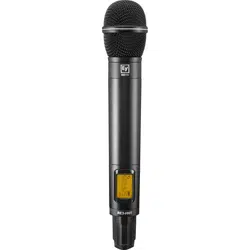Loading ...
Loading ...
Loading ...

64
en | Troubleshooting and FAQ
RE3 UHF
Wireless
20
21.06 | 3 | F.01U.362.808 Installation manual Electro-
Voice
artifacts which would be avoided by staying with our factory groups. Use RE3 factory
groupings. They work well.
Q – Why doesn’t the extra RE3 transmitter I bought online work with my RE3 set?
A – The set you originally purchased was pre-configured with a matching transmitter and
receiver, which both operate in the same frequency band (5L, 5H, 6M, etc.). If you add
another transmitter, it has to be of the same frequency band to work. As this particular
question is about additional transmitters, it should be pointed out that adding a second
transmitter to an existing set with plans to use both transmitters at the same time with the
one existing receiver will not work. At any given time, one of the two transmitters tuned to
the receiver’s frequency must be off. If they are both on and the same time, substantial
interference will occur.
Q – Will the lavalier microphone I have with my older RE-2 system work with RE3?
A – Yes. Legacy Electro-Voice bodypack transmitter input devices with 4-pin mini
connectors are compatible with RE3.
Q – I want to put together an eight-channel RE3 system with two remote antennas on the
stage feeding the receiver rack. What do I need?
A – First, choose the frequency band or bands your system will be operating in. Based on
your location, you’ll need to evaluate available spectrum and how it aligns with the RE3
band options. Knowing that information, one option would be to select the same band for
all eight sets. Another option is to split the eight by selecting four sets from one band, and
the other four from another band, thereby allowing room to compensate for unforeseen
changes. You’ll probably be rack mounting your receivers, so you’ll need four RMK2 dual
rack mount kits, which will mount the eight receivers in four rack spaces. You’ll need two
AASP active antenna splitters which will cascade the RF from two antennas into the eight
receivers. You’ll need either two PLPA passive log periodic antennas, or two ALPA active
log periodic antennas on stage. They will mount on standard microphone stands. Choosing
between the two will be influenced by coverage area and the length of antenna cable
between antenna and receiver rack. The PLPA, although passive, has 10dB of passive gain,
and may be fine if the receiver rack is on stage, however the ALPA active antenna has
adjustable gain (selectable 3dB and 10dB amplified), and if the cable run to the receiver
rack is lengthy, it may be the best choice. You decide. You’ll need TWO low-loss coax
cables to run the antenna signals to the first AASP splitter. Choices are RE3-ACC-CXU25
twenty-five foot, RE3-ACC-CXU50 fifty foot, RE3-ACC-CXU75 seventy-five foot, or RE3-ACC-
CXU100 one hundred foot. The splitter has all cables required if you connect your remote
antenna cables to the rear of the first AASP, but if you want to attach the antenna cables at
the front of the rack, you’ll need to add an RE3-ACC-CXUF rear to front mount antenna
cable kit. That should do it.
Q – Why am I not seeing much audio level on my receiver AF meter?
Loading ...
Loading ...
Loading ...
